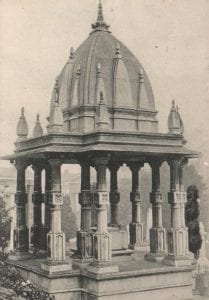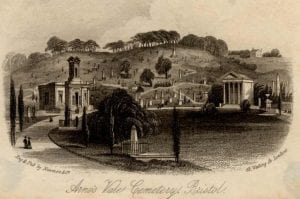Arnos Vale Cemetery archive now open
Posted on by Fay Curtis.
By Graham Tratt, Archivist
The records of Arnos Vale Cemetery are now available for research at Bristol Archives. The collection documents how this Victorian cemetery developed and records the generations of Bristol people laid to rest in its grounds.
Arnos Vale Cemetery was set up in Brislington by the Bristol General Cemetery Company. The company was established by a private Act of Parliament in 1837 and the cemetery started receiving burials in 1839. It was not popular at first, due to its high fees and out-of-town location. However, the number of burials increased after 1854, when new laws closed the overcrowded parish churchyards in central Bristol.

The tomb of Rajah Ram Mohun Roy (ref. 43207/26/1/27)
Amongst the cemetery’s most notable residents are figures such as Rajah Ram Mohun Roy (1772-1833). He was a Hindu reformer who died during a visit to Bristol. His Grade II* listed chattri (a Bengali funeral monument) is near the main entrance.
George Müller (1805-1898), who built an orphanage in Ashley Down, is also buried there.
So too is Mary Carpenter (1807-1877), who set up the Red Lodge reformatory school for girls on Park Row.
By the early 20th century, Bristol’s suburbs had expanded around the cemetery and it could no longer extend its grounds. In 1928 there was limited space left for new graves. The company, therefore, built one of the first crematoria in the west of England.
The cemetery was in a difficult financial position by the 1980s. Fewer burials and more cremations meant less income. The lack of money for maintenance and security led to neglect and vandalism. In 1998, the owners of Arnos Vale lost their cremation licence and announced they were closing the site.
With strong local support for saving the cemetery, Bristol City Council took legal action and gained ownership of the site in 2003. The grounds are now overseen and maintained by the Arnos Vale Cemetery Trust.

An early illustration of Arnos Vale cemetery (ref PicBox/2/BBg/102)
This complex history is reflected in the company records. They include minutes, correspondence and legal papers. Together, they document how Arnos Vale was used and managed as a private cemetery.
Financial records, including ledgers and wage books, reveal the financial pressures the company was under at different times. The collection also contains plans of 20th century alterations to the cemetery buildings, showing how the company needed to maintain and update them.
Alongside these papers, there are registers of the 170,000 burials and 120,000 cremations that have taken place at Arnos Vale. There are also plot books which record the layout of the graves and who has purchased particular plots.
These record books are key sources for family history research and we’re looking forward to helping researchers use these records. The original registers are too fragile to be handled but we have digital copies available in our searchroom.
Find out more
- Visit our online catalogue to see the catalogue for the Arnos Vale Cemetery collection (ref. 41455).
- If you would like to view these records, find out about visiting our public searchroom.
- If you can’t visit Bristol Archives, contact the Arnos Vale Cemetery Trust, who can carry out record searches for you.
Material from the Arnos Vale archive features in our Documenting death exhibition until 1 May 2020.